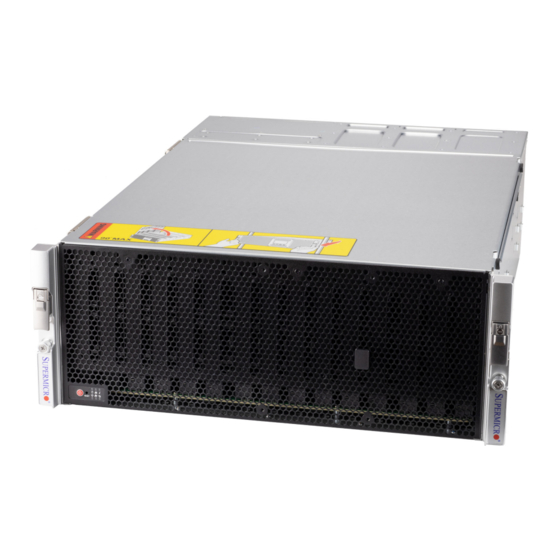
Table of Contents
Advertisement
Quick Links
Advertisement
Table of Contents
Troubleshooting

Summarization of Contents
Chapter 1 Introduction
Overview
Provides an overview of the server's specifications and capabilities.
System Views and Features
Details front, rear, top views, control panel, and drive carrier indicators.
System Architecture
Lists the system's electronic components.
Motherboard Layout and References
Details the motherboard layout, block diagram, and quick references.
Chapter 2 Server Installation
System Installation Overview
Introduces the chapter on mounting the system in a server rack.
Preparation and Precautions
Covers unpacking, setup location, rack/server precautions, and environmental considerations.
Installing the Rails
Details the process of installing rack rails onto the chassis and rack.
Chassis Installation and Removal
Describes installing the chassis into the rack and removing it.
Chapter 3 Maintenance and Component Installation
Power and Safety Procedures
Covers power removal, safety, battery replacement, and power supply replacement.
Processor and Memory Installation
Guides for installing processors, heatsinks, and memory modules.
Storage Drive Management
Procedures for installing, removing, and managing storage drives.
Cooling System Maintenance
Instructions for fan replacement and ensuring proper airflow.
Chapter 4 Motherboard Connections
System Ports and Interfaces
Describes I/O ports, power connections, and network interfaces.
Motherboard Headers and Connectors
Explains various headers for fans, TPM, SGPIO, IPMI, etc.
Control Panel and Buttons
Details connections for the front panel control buttons and LEDs.
Jumpers and LED Indicators
Explains jumper settings and the function of various LEDs.
Chapter 5 Software
Microsoft Windows OS Installation
Guide for installing the Windows operating system.
Driver Installation
Instructions for installing system drivers and utilities.
System Monitoring Tools
Details SuperDoctor 5 for system health monitoring.
BMC and Management
Information on Baseboard Management Controller (BMC) configuration.
Chapter 6 Optional Components
Optional Hardware Overview
Lists optional parts like storage drives, TPM, and RAID keys.
Intel VROC and NVMe RAID Configuration
Details VROC setup, requirements, and manual NVMe RAID configuration.
Drive Status and Hot-Swap
Explains drive status LEDs and hot-swap procedures for NVMe drives.
Cable Management Arm Installation
Instructions for installing the cable management arm.
Chapter 7 Troubleshooting and Support
Information Resources and IPMI
Lists resources and introduces the Intelligent Platform Management Interface (IPMI).
Troubleshooting Procedures
Provides steps for diagnosing and resolving common system issues like no power or boot failure.
Error Handling and Diagnostics
Explains crash dumps, CMOS clearing, and BMC resets.
Support and Contact Information
Details how to get replacement parts, report issues, and contact support.
Appendix A Standardized Warning Statements for AC Systems
Warning Definitions and General Safety
Explains warning symbols and general safety guidelines.
Installation and Electrical Safety
Covers installation instructions, circuit breakers, and power disconnection warnings.
Component Handling and Electrical Safety
Details warnings for component installation, battery, fans, cables, and power supplies.
Regulatory Compliance and Disposal
Covers compliance with electrical codes and product disposal regulations.
Appendix B System Specifications
Core System Components
Details specifications for processors, chipset, BIOS, memory, and storage.
Physical and Connectivity Features
Covers expansion slots, I/O ports, motherboard, and chassis.
Power, Cooling, and Environment
Lists specifications for power supply, cooling system, and operating environment.
Safety, Compliance, and Directives
Outlines safety certifications, regulatory compliance, and applicable directives.















Need help?
Do you have a question about the SuperServer SSG-540P-E1CTR45H and is the answer not in the manual?
Questions and answers